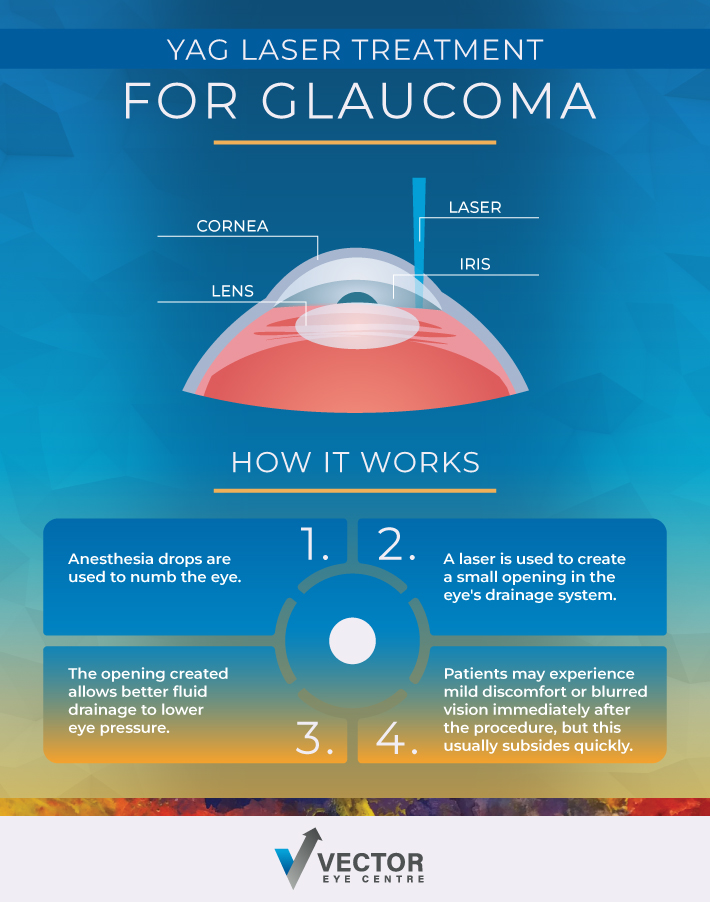Glaucoma is a serious eye condition that can lead to irreversible vision loss without treatment. While glaucoma can seriously damage a person’s vision, it can also be treated if it’s detected early. One emerging solution is the use of YAG lasers.
YAG lasers are used in a procedure called laser peripheral iridotomy, which creates a small opening in the iris (the coloured part of the eye) to prevent a blockage in fluid drainage from the back to the front of the eye. This helps prevent sudden increases in intraocular pressure (IOP), addressing one of the primary concerns in acute angle-closure glaucoma.
How Does Glaucoma Affect Vision?
Glaucoma is a group of eye conditions that damage the optic nerve, often due to high pressure in the eye. If untreated, this damage can lead to vision loss and, eventually, blindness. Early detection and treatment are crucial for preserving vision.
Symptoms of glaucoma can vary and may not appear until vision loss has occurred. If symptoms do show, they may include:
- Gradual loss of peripheral vision
- Tunnel vision in advanced stages
- Eye pain and redness
- Nausea and vomiting
- Blurred vision
Types of Glaucoma
The 2 most common types of glaucoma are primary open-angle glaucoma and angle-closure glaucoma. While these are the 2 most prevalent forms, other types of glaucoma also exist, each with unique characteristics and treatment options.
Primary Open-Angle Glaucoma
While it’s unclear what causes this type of glaucoma, it occurs when the drainage canals in the eye become clogged over time, leading to increased intraocular pressure (IOP). It progresses slowly and often goes unnoticed until significant vision loss occurs.
Regular eye examinations are crucial for early detection, as many individuals may not experience symptoms until the condition is advanced.
Angle-Closure Glaucoma
Angle-closure glaucoma happens when the iris bulges forward, narrowing or blocking the drainage angle formed by the cornea and iris.
This type can present suddenly and may cause rapid symptoms such as severe eye pain, headache, nausea, and visual disturbances. It is considered a medical emergency and requires immediate treatment to prevent permanent vision loss.
Traditional Treatments for Glaucoma
Traditionally, glaucoma treatments have included medications, laser therapy, and surgery. Eye drops are commonly prescribed to lower IOP. Additionally:
- Laser trabeculoplasty is used to open the drainage angle of the eye. This procedure is often used for primary open-angle glaucoma.
- Microsurgery, like trabeculectomy, creates a new drainage path for eye fluid.
How YAG Lasers Are Used in Glaucoma Treatment
The YAG laser is particularly effective in treating angle-closure glaucoma. In this condition, the drainage angle formed by the cornea and iris becomes narrowed or blocked, leading to a rapid rise in IOP and acute symptoms.
The YAG laser procedure, known as laser peripheral iridotomy (LPI), involves creating a small opening in the peripheral iris to facilitate fluid drainage and alleviate pressure in the eye.
How YAG Lasers Work to Treat Glaucoma
YAG laser peripheral iridotomy is a proactive, painless intervention primarily aimed at preventing the onset of acute angle-closure glaucoma rather than reversing its effects once the condition has developed. This procedure effectively creates a new drainage pathway for the aqueous humor, alleviating IOP and significantly reducing the risk of acute glaucoma attacks in high-risk individuals. For patients already experiencing glaucoma, particularly in the advanced stages, YAG laser treatment can help manage pressure but is not a cure.
The YAG laser targets the eye’s drainage system to improve fluid outflow and reduce IOP.
The procedure typically involves:
- Anesthesia drops to numb the eye.
- Using a specialized contact lens to position and stabilize the eye.
- Using a laser to create a small opening in the eye’s drainage system.
This minimally invasive procedure usually takes only a few minutes and has shown promise in effectively managing glaucoma symptoms.

YAG Laser Treatment Success Rates
Studies have demonstrated that YAG laser treatment significantly reduces IOP in many patients. However, success rates can vary based on factors like the type and severity of glaucoma, patient age, and overall eye health. YAG laser treatment has been shown to be a viable option for many glaucoma patients.
Side Effects of YAG Laser Treatment for Glaucoma
While YAG laser treatments are generally safe, they are not without potential side effects. Some patients may experience:
- Mild discomfort post-procedure
- Inflammation or swelling
- Temporary increase in eye pressure
- Light sensitivity
The Future of Glaucoma Treatment
Advancements in laser technology continue to improve the efficacy and safety of glaucoma treatments. Researchers are exploring ways to enhance the precision and outcomes of YAG laser procedures. Future developments may include:
- More targeted laser applications
- Combination therapies with medications
- Enhanced imaging techniques to guide laser treatment
These advancements hold promise for even better management of glaucoma in the coming years.
Find Out if YAG Laser Treatment Is Right for You
YAG laser treatment offers a promising alternative for glaucoma patients looking to manage their condition effectively. Its minimally invasive nature and ability to reduce IOP make it a compelling option.
However, as with all medical treatments, it’s crucial to consult with a qualified eye care provider to determine the best approach for your specific needs.For more information on YAG laser treatment and other innovative glaucoma treatments, contact Vector Eye Centre or ask your eye doctor for a referral.



